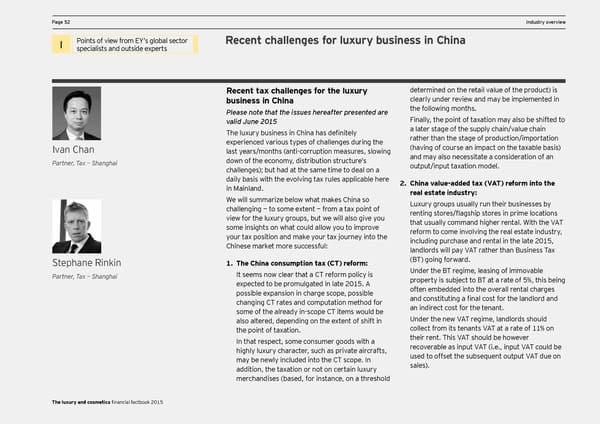PPage 52age 52 DCF and valuation pIndustry oaramevervieterws I Points of view from EY’s global sector Recent challenges for luxury business in China specialists and outside experts Recent tax challenges for the luxury determined on the retail value of the product) is business in China clearly under review and may be implemented in Please note that the issues hereafter presented are the following months. valid June 2015 Finally, the point of taxation may also be shifted to The luxury business in China has definitely a later stage of the supply chain/value chain experienced various types of challenges during the rather than the stage of production/importation Ivan Chan last years/months (anti-corruption measures, slowing (having of course an impact on the taxable basis) down of the economy, distribution structure’s and may also necessitate a consideration of an Partner, Tax — Shanghai challenges); but had at the same time to deal on a output/input taxation model. daily basis with the evolving tax rules applicable here 2. China value-added tax (VAT) reform into the in Mainland. real estate industry: We will summarize below what makes China so Luxury groups usually run their businesses by challenging — to some extent — from a tax point of renting stores/flagship stores in prime locations view for the luxury groups, but we will also give you that usually command higher rental. With the VAT some insights on what could allow you to improve reform to come involving the real estate industry, your tax position and make your tax journey into the including purchase and rental in the late 2015, Chinese market more successful: landlords will pay VAT rather than Business Tax Stephane Rinkin 1. The China consumption tax (CT) reform: (BT) going forward. Partner, Tax — Shanghai It seems now clear that a CT reform policy is Under the BT regime, leasing of immovable expected to be promulgated in late 2015. A property is subject to BT at a rate of 5%, this being possible expansion in charge scope, possible often embedded into the overall rental charges changing CT rates and computation method for and constituting a final cost for the landlord and some of the already in-scope CT items would be an indirect cost for the tenant. also altered, depending on the extent of shift in Under the new VAT regime, landlords should the point of taxation. collect from its tenants VAT at a rate of 11% on In that respect, some consumer goods with a their rent. This VAT should be however highly luxury character, such as private aircrafts, recoverable as input VAT (i.e., input VAT could be may be newly included into the CT scope. In used to offset the subsequent output VAT due on addition, the taxation or not on certain luxury sales). merchandises (based, for instance, on a threshold The luxury and cosmetics financial factbook 2015
 Seeking sustainable growth - The luxury and cosmetics financial factbook Page 53 Page 55
Seeking sustainable growth - The luxury and cosmetics financial factbook Page 53 Page 55